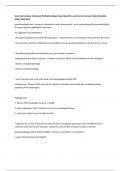Gastroenterology- Advanced Pathophysiology Exam Questions and Correct Answers (Latest Update
2024) 100% Pass
gastrointestinal tract - Answers -alimentary canal= from mouth-> anus and includes all associated glands
& organs (eg liver, gallbladder, pancreas)
-Fx: digestion and metabolism
-development begins in the 4th wk of gestation-> tube-like from oral opening to cloaca (end of the tract)
-the canal then dissolves/obliterates & recanalizes from an opening inside the body that forms a canal
*disruption during the recanalization can cause atresia or stenosis
esophageal atresia (EA) & stenosis - Answers -caused by failure of recanalization of the esophagus
-atresia= complete blockage
-stenosis= partial blockage
*most common type is EA with distal tracheoesophageal fistula (TEF)
hiatal hernia - Answers When part of the stomach protrudes out through the esophageal hiatus
(opening of the diaphragm)
Pathogenesis:
1. failure of the esophagus to grow in length
2. short esophagus "pulls" stomach up into the esophageal hiatus
3. other gut contents may herniate as well
*hiatal hernia is a key risk factor for reflux (risk b/c esophageal squamous cells are different from
columnar cells that line the stomach.. squamous cells are less resistant to acidic contents)
gastroesophageal reflux disease (GERD) - Answers -acid reflux + GI symptoms
-causes impaired mucosal integrity
,-genetic & environmental factors; comorbidity with asthma/cough d/t irritation of airway, and chest
pain
-long-term exposure of squamous cells in esophagus at the LES juncture to acidic stomach contents->
increased risk for cellular changes and esophageal CA
-potential effects: esophagitis, stricture, Barrett's esophagus, esophageal adenocarcinoma
Pathogenesis from:
-lower esophageal sphincter (LES) dysfunction -> d/t anatomical anomalies like hiatal hernia, weakened
resting tone r/t smoking, stress, EtOH, medications that relax LES (circular muscle fibers relaxed), H.
pylori
*Meds r/t GERD: NSAID, ASA, oral steroid nitrate, anticholinergic, antirheumatic
-increased intra-abd pressure that forces stomach contents upward-> d/t obesity (2x more likely for
GERD), respiratory disease (eg. emphysema), hepatosplenomegaly, musculoskeletal (eg.
scoliosis/kyphosis), GI pathology (eg. strictures/adhesions secondary to surgeries & endometriosis)
-dysfunctional GI motility-> d/t food allergies, stress, dysbiosis (abnormal gut flora)
-back-up of GI contents-> d/t overfilling of stomach, overfilling from an anomaly (eg.
post-resection/bariatric surgery), constipation (eg. from GOP1 agonists)
GOP1 agonists - Answers -slows gastric emptying, primarily helping with glycemic control in Diabetes
Mellitus and weight loss/obesity by acting on the incretin hormone that is released in the gut in
response to food and affects glucose metabolism
-side effect: constipation
GERD in infants - Answers -some degree of reflux is expected in young infants
-"happy spitters"; not indicative of underlying pathological condition
Causes:
-sphincter tone is not fully mature/LES immaturity (particularly preterm)
, -LES position relative to diaphragm changes (max up to 6 months)
-primarily liquid diet
-lack of truncal tone/poor core strength
-horizontal positioning (often)
-if GERD is significant, look for underlying causes: allergies, food intolerances, visceral hypersensitivity
(low pain threshold of internal organs)
visceral hypersensitivity - Answers -caused by central and neural factors that modulate symptom
perception through stress and psychosocial comorbidities, esophageal hypervigilance, and central
sensitization d/t repetitive nociceptive signals
Tx for GERD - Answers Tx through acid suppression BUT some implications of acid suppression include:
-lower protein digestion (acid is needed to break down proteins)
-higher pH may inhibit the destruction of ingested pathogens so there's an increased infection risk (eg.
C. diff.)
-dysbiosis a/w various problems (eg. C. diff.)
-may be a/w asthma (eg. PPIs)
*Treat the underlying problem whenever possible!
Differential Diagnoses (DDx) for GERD - Answers -CHD-> chest pain
-GI malignancy-> eating difficulties, weight loss, vomiting
-peptic ulcer disease-> epigastric pain, N/V
-biliary tract disease-> abd pain, jaundice
-eosinophilic esophagitis-> swallowing difficulties, reflux symptoms
-achalasia or other upper GI motility disorders-> swallowing difficulties, vomiting of undigested food
Important clinical points for GERD - Answers -"alarm symptoms" suggesting severe underlying
pathology= heartburn AND dysphagia, odynophagia (painful swallowing), weight loss, anorexia, GI
bleeding, &/or vomiting
-need to refer for a upper endoscopy




